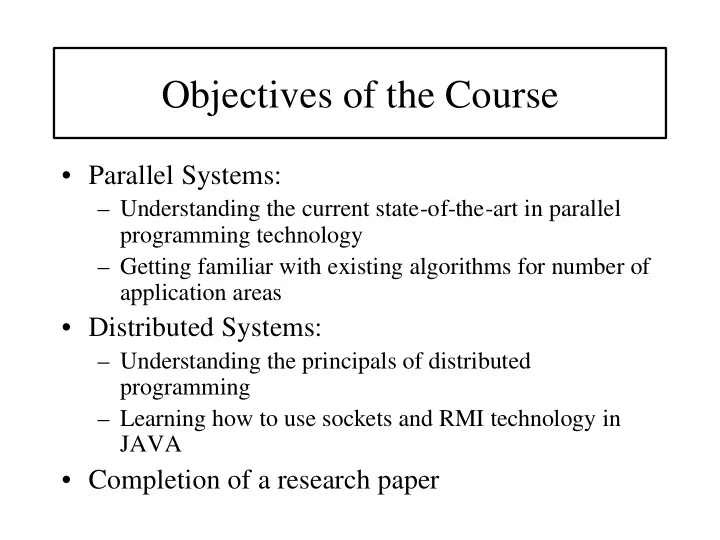

Objectives of the Course • Parallel Systems: – Understanding the current state-of-the-art in parallel programming technology – Getting familiar with existing algorithms for number of application areas • Distributed Systems: – Understanding the principals of distributed programming – Learning how to use sockets and RMI technology in JAVA • Completion of a research paper
Parallel Architecture: motivation • The Von Newman model – Bottlenecks: • The CPU-memory bottleneck • The CPU execution rate • Improvements to the basic model – Memory interleaving and caching – Instruction/execution pipelining
Memory Interleaving To speed up the memory operations (read and write), the main memory of words can be organized as a set of independent memory modules (where each containing words. If these M modules can work in parallel (or in a pipeline fashion), then ideally an M fold speed improvement can be expected. The n-bit address is divided into an m-bit field to specify the module, and another (n-m)-bit field to specify the word in the addressed module. The field for specifying the modules can be either the most or least significant m bits of the address. For example, these are the two arrangements of modules ( ) of a memory of words ( ):
In general, the CPU is more likely to need to access the memory for a set of consecutive words (either a segment of consecutive instructions in a program or the components of a data structure such as an array, the interleaved (low-order) arrangement is preferable as consecutive words are in different modules and can be fetched simultaneously. In case of high- order arrangement, the consecutive words are usually in one module, having multiple modules is not helpful if consecutive words are needed. Example: A memory of words (n=16) with modules (m=4) each containing words:
Logical and Physical Organization • The two fundamental aspects of parallel computing from a programmer perspective: – ways of expressing parallel tasks ( control structure ) • MIMD, SIMD (Single/Multiple Instruction, Multiple Data) – Mechanisms for specifying task-to-task interaction ( communication model ) • Main classification: message passing vs. shared memory • The physical organization of a machine is often (but not necessarily) related to the logical view – Good performance requires good matching between the two views
The Parallelism Structure Taxonomy • The von Neumann model is also called Single Instruction stream – Single Data stream (SISD) • Bottleneck are CPU rate and CPU-memory � Multiply CPUs (MIMD,SPMD) or just the PEs (SIMD) and related memory – SIMD model: same instruction executed synchronously by all execution units on different data – MIMD(and SPMD) model: each processor is capable of executing its own program
SIMD vs. MIMD • SIMD: a single global control unit multiple PE • MIMD: multiple, full blown processors • Examples – SIMD: Illiac IV, CM-2, MasPar MP-1 and MP-2 – MIMD: CM-5, paragon – SPMD: Origin 2000, Cary T3E, Clusters
SIMD vs. MIMD (II) • In general MIMD is more flexible, • SIMD pros: – Requires less hardware: single control unit – Faster communication: single clock means synchronous operation, transfer of data is very much like a register transfer • SIMD cons – Best suited for data-parallel programs – Different nodes cannot execute different instructions in same clock cycle – conditional statement examples!
A Different Taxonomy • SISD, SIMD, MIMD refer mainly to the processor organization • With respect to the memory organization, the two fundamental models are: – Distributed memory architecture • Each processor has its own private memory – Shared address space architecture • Processors have access to the same address space
Memory Organizations I
Memory Organizations (II) • Shared-address-space computers can have a local memory to speed access to non-shared data – Figure (b) and (c) in previous slide – So called Non Uniform Memory Access (NUMA) as opposed to Uniform Memory Access (UMA) has different access times depending on location of data • To alleviate speed difference, local memory can also be used to cache frequently used shared data – Use of cache introduces the issue of cache coherence, – In some architectures local memory is entirely used as cache – so called cache-only memory access (COMA)
Recommend
More recommend